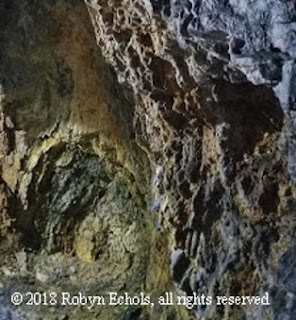The past two summers my travels have taken me to--and into--two historical mines. The Broken Boot Gold Mine is just outside Deadwood, South Dakota. The Lebanon Tunnel mine is in Silver Plume, Colorado, and can be part of your Georgetown Railroad train tour.
Since many of my Old West romances feature mining towns and miners, I found these tours very interesting and educational. A big part of my education included realizing that many of the words I used to describe mines are flat-out wrong.
This post is not going to be everything you ever wanted to know about mining terms. However, it will include a few terms to describe navigating within a mine, as well as a few structures you may find inside mines. The images I've used were taken by me, inside mines with poor lighting, during fast-paced tours involving 20-30 people. Please keep that in mind when judging photo quality.
First of all, most mines are not tunnels, although many of us think of them as that. Tunnels enter one side of a hill, cliff, or mountain and have at least one exit elsewhere. Also, you do not enter a mining shaft unless you are on top of the ground and entering the mine by going down, down, down or down at an angle. The two mines I toured had horizontal entrances. So I entered by what is called an ADIT.
Here is some basic terminology:
Adit – a horizontal opening from the surface into a mine, usually into a mine drift.
 |
| Original adit to the Broken Boot Mine |
Shaft – a vertical opening from the surface into a mine,
tunnel or drift.
Drift – Similar to a tunnel in appearance, a drift goes only
partway through a solid surface, but has no outlet.
 |
| Drift in Lebanon Mine |
Raise – A vertical or inclined passageway driven between
levels of a mine. They are used as manways, ventilation passages, for support
lines such as pipes and electrical lines, for hauling ore from a lower level to
another for removal from the mine, and as ore dumps for transporting ore to lower
levels.
 |
| Winch with lines down a raise to bring up ore from lower level of mine. |
Back – ceiling of a tunnel or drift.
 |
| Miner on top has hand on drift back and chalk marker on a rib of drift. |
Rib – wall of a tunnel or drift.
Working face – a wall of rock in which miners will set
charges to break it into small pieces, the working surface.
 |
| Miners in a drift preparing drill holes on working face of mine. |
Stope – a large, underground room from which ore is removed.
They are formed when miners drill numerous holes in the working face, then fill
them with explosives which they then detonate. Said blasts breaks up the
working face into pieces small enough to be loaded into mining cars and taken
out of the mine. Often the area between two levels of the mine and sometimes
accessed through a raise.
Crib/Crib Sets – in hard rock mining, cribs are the heavy
wood supports that protect and support the drift.
Cap – top timber of the crib set.
Post – side pieces of a crib set that provide vertical
support for the cap.
 |
| Posts - no caps or stringers in this section of the mine. |
Stringer – connecting pieces that join the crib sets.
Square-set Timbers – massive notched beams designed to form
an interlocking series of cubes.
Square-sets – cubes formed by square-set timbers
Back-filling –partially filling open stopes that are no
longer actively mined with waste rock taken from other areas of the mine. This
was done for safety as well as disposal of waste rock.
Test Pocket - Removing rock from the working face far enough to see if there is any sign of ore.
 |
| Test pocket |
Slag - waste rock.
 |
| Slag |
Silver Ore - tends to be black in appearance in its raw state.
 | ||
| Examples of silver embedded in rock. |
I have written seven books for the multi-author series, Sweethearts of Jubilee Springs. Jubilee Springs is a silver mining town set in the Rocky Mountains of Colorado. My most recent book in the series, Two Sisters and the Christmas Groom, is currently available. Please CLICK HERE.
My eighth Sweethearts of Jubilee Springs book, and my next book to be released, Nathan's Nurse, is the first book in which I wrote a scene that took place inside the Prosperity Mine. I went out of my way to be sure the descriptions I used were understandable to those readers who, like I was, are not overly familiar with mining terms. I even asked some authors in my Gold Rush Writers group to give suggestions, which I followed. Still, I hope you found these mining terms above helpful. You may want to refer to them again when this book is published.
Nathan's Nurse is currently on pre-order and is schedule for release on December 27, 2019. You may access the book description and purchase link by CLICKING HERE.
Sources:
Broken Boot Gold Mine in Deadwood, South Dakota
Lebanon Tunnel Mine in Silver Plume, Colorado








1 comment:
Hi Zinna , very, very interesting post, Thank you so much for the lesson. My husband worked in a uranium mine in New Mexico for about a year and a half. I don't think I could ever go that far down in a mine like he used to, it was so very scary just to hear some of the things he said about it. Mines can be very dangerous. I was so very happy when he got another job. Your books sound like very good reads, Thank you so much for posting all this info about the mines and your book. Have a Great weekend.
Post a Comment